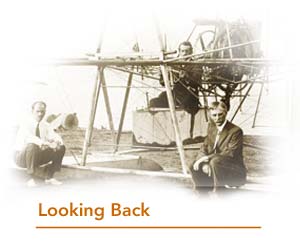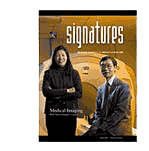
Notre
Dame boasts a long tradition of excellence and innovation in aerospace
research. In fact, some of the wind tunnel technology used today
in federal, industrial, and academic laboratories can be traced to
the work of University faculty, such as Professor Albert
F. Zahm, who developed the first hand-driven wind tunnel in the country and
suggested a better way to launch an aircraft and control its flight;
Professors Frank N.M. Brown and Robert
S. Eikenberry, who not only
built a revolutionary smoke tunnel with a rake and screen feature
but were also the first to visualize Tollmien-Schlichting waves;
and Professor Vincent P. Goddard, who built the world’s
first supersonic smoke tunnel. Much of this work was accomplished
in the “aero shack,” which was adjacent to the Joyce
Center.
Today, the Notre Dame tradition continues in the Hessert Laboratory for Aerospace
Research, which recently celebrated 15 years of service to the University
and its research partners. Since the early days of aeronautics at
Notre Dame, the College of Engineering has developed a cadre of faculty
who are still making their mark on a number of industries, including
aerospace and transportation. The 38,000-sq.-ft. Hessert Laboratory,
named for its benefactors Thomas J. and Marilyn
Hennebry Hessert, contains cutting-edge facilities, such as the Advanced Performance
Compressor Laboratory, the Gas-Turbine Laboratory, the Aero-optics
Clean Room, the Particle Dynamics Laboratory, the Plasma Flow Control
Laboratory, an anechoic chamber, a Mach .05 low-disturbance wind
tunnel, an atmospheric wind tunnel, a planar jet facility, high-speed
supersonic and transonic wind tunnels, and dedicated machine and
electronic shops.
It is also home to the Center for Flow Physics and Control, created
specifically to continue to develop techniques for modifying fluid
flows — through aero-acoustics,
aero-optics, fluid-structure interactions, multiphase flows, gas-turbine
engines, and flow control — for
important applications through multidisciplinary activities.
For more information
about the Hessert Laboratory, visit http://www.nd.edu/~ame/facilities/Hessert.html.

Attendees of the 15th anniversary celebration of the Hessert
Laboratory for Aerospace Research echo a pose from the groundbreaking
of the building in 1990. From left to right are Stephen M. Batill,
professor and chair of the Department of Aerospace and Mechanical
Engineering; Professor Flint O. Thomas; Professor Robert C. Nelson;
Marilyn Hennebry Hessert; and Thomas J. Hessert (B.S., Commerce ’48), founder
and former president of the T.J.H. Investment Company; and Roth-Gibson
Professor Emeritus Thomas J. Mueller. The facility was dedicated
in November 1991 during the University’s sesquicentennial activities. |
 Aerodynamicist Albert
F. Zahm was the first professor of mechanical engineering
at the University. He also built the first hand-driven wind tunnel
in the United States and organized the first International Aeronautical
Congress, which was held in Chicago during the 1893 World’s
Fair. Known on-campus for his late-night glider flights, which
were launched from the roofs of University buildings, Zahm had
a tremendous influence on the history of aerospace research in
the U.S. In fact, he was the first to discuss a modern method of
launching an airplane and controlling its flight — by rotating
parts of the wings to balance it laterally while using a double
tail to decrease pitching and yawing. He also made contributions
to aerospace research at the University. It is a tradition that
continues today. Aerodynamicist Albert
F. Zahm was the first professor of mechanical engineering
at the University. He also built the first hand-driven wind tunnel
in the United States and organized the first International Aeronautical
Congress, which was held in Chicago during the 1893 World’s
Fair. Known on-campus for his late-night glider flights, which
were launched from the roofs of University buildings, Zahm had
a tremendous influence on the history of aerospace research in
the U.S. In fact, he was the first to discuss a modern method of
launching an airplane and controlling its flight — by rotating
parts of the wings to balance it laterally while using a double
tail to decrease pitching and yawing. He also made contributions
to aerospace research at the University. It is a tradition that
continues today.
|




 Aerodynamicist Albert
F. Zahm was the first professor of mechanical engineering
at the University. He also built the first hand-driven wind tunnel
in the United States and organized the first International Aeronautical
Congress, which was held in Chicago during the 1893 World’s
Fair. Known on-campus for his late-night glider flights, which
were launched from the roofs of University buildings, Zahm had
a tremendous influence on the history of aerospace research in
the U.S. In fact, he was the first to discuss a modern method of
launching an airplane and controlling its flight — by rotating
parts of the wings to balance it laterally while using a double
tail to decrease pitching and yawing. He also made contributions
to aerospace research at the University. It is a tradition that
continues today.
Aerodynamicist Albert
F. Zahm was the first professor of mechanical engineering
at the University. He also built the first hand-driven wind tunnel
in the United States and organized the first International Aeronautical
Congress, which was held in Chicago during the 1893 World’s
Fair. Known on-campus for his late-night glider flights, which
were launched from the roofs of University buildings, Zahm had
a tremendous influence on the history of aerospace research in
the U.S. In fact, he was the first to discuss a modern method of
launching an airplane and controlling its flight — by rotating
parts of the wings to balance it laterally while using a double
tail to decrease pitching and yawing. He also made contributions
to aerospace research at the University. It is a tradition that
continues today.